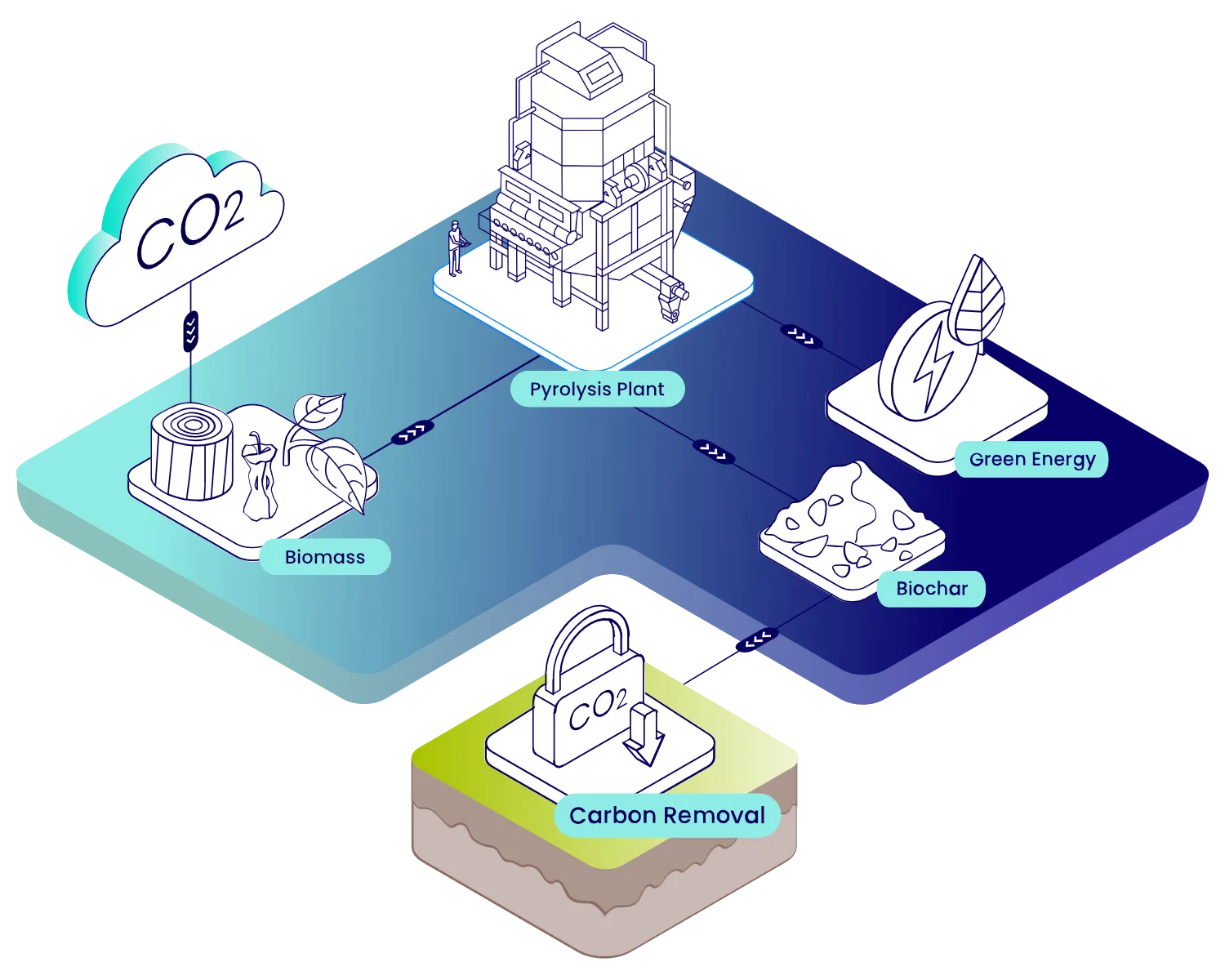Pyrolysis
Converting undervalued biomass into carbon credits, valuable biochar and green energy

What is pyrolysis?
Pyrolysis is the thermal treatment of a feedstock in an oxygen-limited environment. Treating the feedstock in this way avoids combustion of the raw input material and produces syngas and char.
Syngas is made up of combustible gases and can be combusted in a controlled way for renewable energy production, whilst char is a valuable product in its own right.
If the feedstock material is biomass, the resultant char is known as biochar. This carbon-rich product is even more valuable than char from inorganic sources, and can be used to sequester carbon in soils for hundreds of years.

Want to know more about our pyrolysis technology?
CarboFlow was designed and engineered with the aim to make pyrolysis commercially viable for more projects.
A self-sustaining process
The pyrolysis process begins with organic feedstock entering the feeder. This feedstock has been dried to below 20% moisture content.
The feedstock enters into the reactor, where it is heated to above 600 degrees. Feedstock in the chamber is thermally decomposed into syngas and biochar.
The syngas is then combusted in the upper section of the chamber to provide the heat required for the process. Because of this, no external heat source is required to power the process once it has been started.

Perfect pyrolysis
The pyrolysis conditions can be altered to change the outputs of the process. This can be used to achieve project specific goals, for example maximum carbon sequestration in the biochar, or maximum syngas yield.
The parameters that can be altered include:
- Temperature
- Residence time
- Pressure
- Heating rate
- Amount of oxygen present

Clean energy production
One of the advantages of pyrolysis compared to other waste-to-energy technologies is the cleaner energy production.
The sophisticated filtration system used in pyrolysis means less pollutants and particulate matter are emitted. As well as this, the absence of oxygen reduces the number of dioxins that can be formed.
In processes like incineration, heavy metals from the feedstock can leach from the ash created into landfill or soil. The stable nature of biochar reduces this leaching, and even offers opportunity for heavy metal recovery. PAHs in the feedstock are removed during the pyrolysis process.

How does pyrolysis compare with other renewables?
Pyrolysis is the only sustainable energy source that is carbon negative, not just carbon neutral.
While solar, wind and most biomass energy is used to generate electricity, pyrolysis is at its best supplying a heat or cold energy source locally. If that’s what is needed, there are considerable advantages over other methods.

Scaling pyrolysis
Pyrolysis has been in use since ancient times, and there is evidence that biochar has been used as a soil additive in South America for thousands of years.
The availability of specialist equipment has seen a sharp increase in capacity with 250 working plants worldwide. And the recent recognition of the technology by regulatory bodies as a certified carbon removal method means we are at the beginning of a huge increase in interest and deployment.
Pyrolysis using biomass in Europe is currently removing 100,000 tCO2e from the atmosphere annually, compared to only 4,000 tCO2e by direct air capture (DACCS), making it by far the most effective carbon removal technology available. As this becomes more widely understood we can expect a major proliferation of the technology in the coming years.

What is Biochar?
Volatile solids are gasified, and the biomass is transformed into a carbon rich product.
The resulting biochar has up to 90% fixed carbon which makes it a valuable carbon sink.

Biochar's many properties make it an excellent soil additive, but it can also be used for a variety of other applications
Biochar is a recalcitrant which means it can endure in soils for hundreds of years
Want to know more about pyrolysis?
Our experts can explain this multi-step complex process in a simple and effective way.






